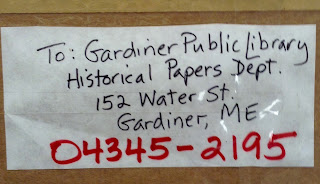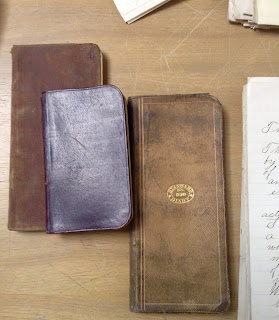A box arrived in the mail on Friday, out of the blue and addressed as shown:
“Historical Papers Dept.” is a wonderful way of describing our Community Archives Room, which is where the box was swiftly taken and immediately given a new and permanent home. As many of you know, the C.A.R. first opened in 1985, was renovated into a beautiful, climate controlled space last year, and was re-dedicated just last month. It is home to a collection of unique and engaging local history materials and artifacts covering the historic past of Gardiner and its surrounding towns, as well as family histories and papers of those who lived here “way back when.”
Such personal collections really help bring our history to life and Friday’s package did not disappoint. It contained dozens of letters, two diaries, and several receipts from a Gardiner family in the late 1880s into the early 1890s. What’s more, they were an addition of newly found items that will round out a family collection that was donated to us nearly ten years ago. It short, it was a most welcome surprise!

Of all the materials we keep in the archives, I most appreciate the opportunity to care for and preserve family papers. They are so personal and, by far, the best way I know to step back in time and see history and daily life through the eyes of those who lived it. Receipts, such as the one above (from a local shop in 1890), afford us a snapshot of home life — cooking and shopping habits — as well as business workings (prices, billing practices, inventory) over a century ago. The diaries, shown below, are an especially personal look at day-to-day — from descriptions of the weather to train rides and work life — and even marriage customs!
 |
| These two diary entries cover the mundane (work, haircut, finances) to the monumental (getting married!), as well as heading off on the Pullman for a rainy honeymoon in Passadumkeag. |
And then there are the letters… In this package they covered the courtship (leading up to the wedding above) and early years of marriage of a local couple. Reading and organizing them carries one through the stories of life — at times tragic, but often delightful. The young woman in this case lost her father when she was a child and her mother when she was a teen, leaving her to look after her younger sister and board with family and friends until her marriage in 1891. Among the correspondence were also letters between mother and daughter, as well as one earlier gem (below) that was sent to her mother in 1862. It includes brilliant fabric samples (and prices per yard) for a dress a friend was sewing; the samples are hand-sewn onto the letter itself. It’s a lovely letter and a wonderful reminder that those dresses in black and white Civil War era photographs were rarely ever black or white!

So, what will we do with these new-to-us treasures? They will be arranged and cataloged and join their compatriots in archival folders and boxes, housed in the Community Archives Room. They will be available for reference and research (whether informal or scholarly) and will help future generations to form a truly compelling and detailed picture of our local history through primary sources.
And in the near future some of them just might find their way into a curated display in our new exhibit case in the Reading Room…
Stay tuned!
– Dawn Thistle, Special Collections Librarian










